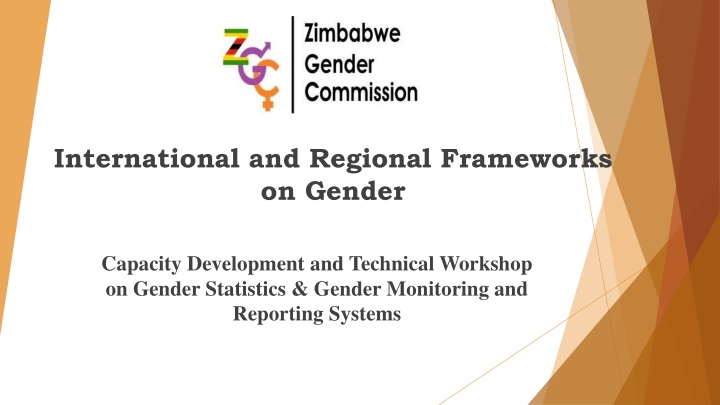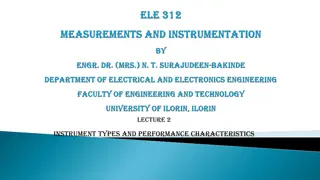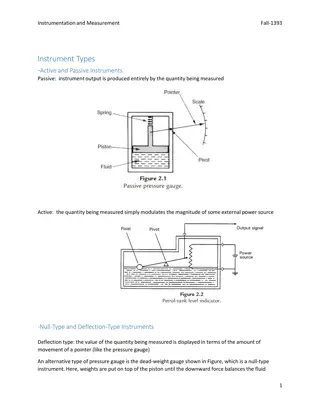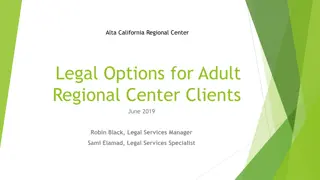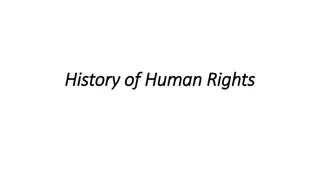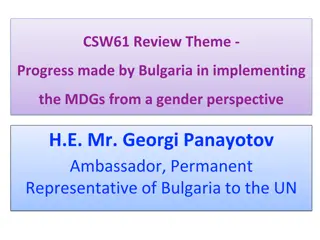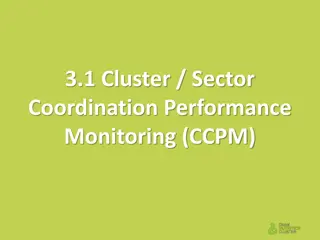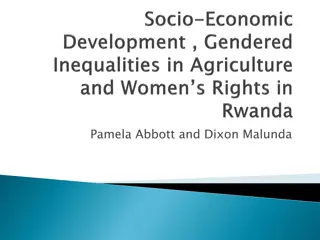International and Regional Frameworks on Gender: Instruments and Legal Rights
Zimbabwe is part of international and regional gender equality frameworks, including laws, conventions, and protocols. These frameworks encompass human rights, discrimination, and gender empowerment. The content explores various instruments and legal agreements aimed at promoting gender equality and women's rights at global and regional levels.
Download Presentation

Please find below an Image/Link to download the presentation.
The content on the website is provided AS IS for your information and personal use only. It may not be sold, licensed, or shared on other websites without obtaining consent from the author.If you encounter any issues during the download, it is possible that the publisher has removed the file from their server.
You are allowed to download the files provided on this website for personal or commercial use, subject to the condition that they are used lawfully. All files are the property of their respective owners.
The content on the website is provided AS IS for your information and personal use only. It may not be sold, licensed, or shared on other websites without obtaining consent from the author.
E N D
Presentation Transcript
International and Regional Frameworks on Gender Capacity Development and Technical Workshop on Gender Statistics & Gender Monitoring and Reporting Systems
Introduction Zimbabwe is party to several international, regional and sub-regional instruments for gender equality and the empowerment of women and girls. Types of frameworks Laws Binding instruments e.g. Conventions (CEDAW), Protocols (the Maputo Protocol) Non-binding instruments e.g. Declarations (DEVAW). Policy Documents E.g. Beijing Platform for Action, Sustainable Development Goals framework.
What ARE these instruments? Universal Declaration of Human Rights Convention on the Elimination of All Forms of Discrimination Against Women (13 May 1991 ) The International Covenant on Civil and Political Rights (Acceded May 1991) The International Covenant on Economic Social and Cultural Rights (Acceded May 1991) The Convention on the Political Rights of Women ( Zimbabwe has not ratified)
Instruments The Protocol to Prevent, Suppress and Punish Trafficking in Persons especially Women and Children Palermo Protocol (Feb 2012) Equal Remuneration Convention, 1951 (No. 100) (ratified 14 December 1989) Discrimination (Employment and Occupation) Convention, 1958 (No. 111) (ratified 23 June 1999) Workers with Family Responsibilities Convention, 1981 (No. 156) (Zimbabwe has not ratified)
Instruments Regional Instruments African Charter on Human and Peoples Rights (1986) The Protocol to the African Charter on Human and Peoples Rights on the Rights of Women in Africa (Maputo Protocol) (2008) Sub-regional instruments The SADC Protocol on Gender and Development (2009)
International Legal Instruments: UDHR The Universal Declaration of Human Rights was adopted by the United Nations General Assembly on 10 December 1948. The Declaration represents the first global expression of rights to which all human beings are inherently entitled. It serves as the foundation for other international laws and treaties protecting and promoting human rights.
International Legal Instruments: UDHR The UDHR incorporates the goal of achieving gender equality The Preamble to the UDHR affirms in the equal rights of men and women and have determined to promote social progress and better standards of life in larger freedom (para 5). Article 2 of the UDHR states that: Everyone is entitled to all the rights and freedoms set forth in this Declaration, without distinction of any kind, such as race, colour, sex or other status.
International Legal Instruments: CEDAW It defines "discrimination against women" as any distinction, exclusion or restriction made on the basis of sex which has the effect or purpose of impairing or nullifying the recognition, enjoyment or exercise by women, irrespective of their marital status, on a basis of equality of men and women, of human rights and fundamental freedoms in the political, economic, social, cultural, civil or any other field.
International Legal Instruments: CEDAW The CEDAW provides framework to guide all rights-based action for gender equality. It calls for equality in outcomes rather than simply equality in opportunities e.g. it is not sufficient that anti-discrimination laws are put in place; the state has the obligation to take all necessary steps to ensure that women actually enjoy equality in their daily lives. a comprehensive
Thematic issues in international/regional Legal Instruments OUTLAWING DISCRIMINATION States parties are required to work towards elimination of all forms of discrimination against women and girls ( African Protocol article 2-CEDAW) Culture and traditional practices the modification of social and cultural patterns of individual conduct in order to eliminate "prejudices and customary and all other practices which are based on the idea of the inferiority or the superiority of either of the sexes or on stereotyped roles for men and women" (Article 5-CEDAW).
Thematic issues in International and regional Legal Instruments Elimination of harmful practices State parties prohibit and condemn harmful practices that negatively affect the human rights of women Rights in marriage and family context 1. Minimum age of marriage is 18-CEDAW/African Protocol/SADC Protocol 2. Full and Free consent to marriage (registered marriages??) 3. Monogamy is encouraged as preferred form of marriage & rights of women on polygamous relationships be protected
Monitoring of rights in instruments Most instruments create human rights monitoring bodies State party reporting Complaints mechanisms
National reporting obligations States must abide by the treaty guidelines to demonstrate their compliance and periodically report to United Nations committees. Independent bodies of experts form the committees that monitor implementation by reviewing state reports and issuing concluding observations and recommendations. Although the exact reporting requirements vary, typically state parties must submit an initial report within one year of ratifying a convention. Periodic reports are subsequently due at regular intervals set by each committee. Additional reports may be required if state parties have acceded to any optional protocols.
Thematic issues in International/regional Legal Instruments VIOLENCE AGAINST WOMEN AND GIRLS Bodily integrity, security or the person, - African Protocol and SADC protocol; DEVAW State obligations on prevention, provision of services, Sexual harassment SADC Protocol Trafficking of women and girls
Thematic issues in International/regional Legal Instruments Health and Reproductive Rights (SADC Protocol and African Protocol) Rights of women to control their fertility Protection against STI infections including HIV/ensure universal access to HIV treatment for women and girls Right to be informed of one s health status and health status of one s partner if infected with STI including HIV Protection of reproductive rights of women including medical termination of pregnancies in cases of rape, incest, sexual assault, pregnancies that endanger mental and physical well being or life of the mother or foetus
Thematic issues in International/regional Legal Instruments Gender Parity in participation and representation Access to justice and protection of the law Right to peace Socio-economic rights education, health, economic participation, food, housing, Positive cultural context Healthy and sustainable environment Sustainable development Disability , elderly, inheritance
Thematic issues in International/regional Legal Instruments ILO Labour conventions 1. Maternity Protection 2. Rights on equal remuneration between men and women 3. Equality and on-discrimination in the work place 4. Protection against sexual harassment 5. Rights of workers with family responsibilities-no discrimination because of perceived conflict between work and family responsibilities 6. Rights of domestic workers
Sustainable development goals Continuation of the unfinished MDGs Agenda Sustainable Development Goals- More refined specific targeted Specific Targets and indicators Gender Equality-two track approach (stand alone Goal and mainstreaming in other SDGs GOAL 5 Gender Equality and Empowerment of women and girls
Conclusion There are several normative frameworks that protect women and girls and seek to eliminate gender biases and discrimination. Implementation remains key and the Gender Commission is strategically positioned to ensure the implementation of these instruments.
